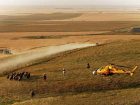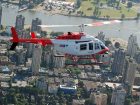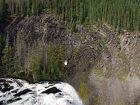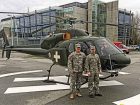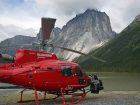
Features
Commercial
Operator Profiles
Lights, Camera, Action!
January 11, 2016 By Paul Dixon
Aviation, photography and movies – it’s a creative bond that goes back to the very inception of flight. Wilbur Wright, for example, is credited with the first use of a movie camera from an aircraft in April 1909. Not long after, the First World War saw the wide acceptance of aerial photography and the post-war years saw a surplus of aircraft and trained pilots, a combination that was a boon to the nascent motion picture industry.
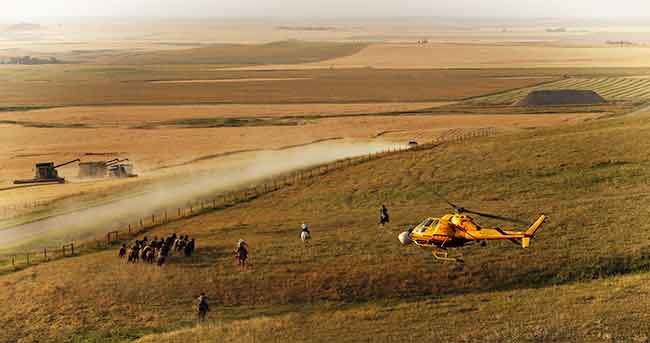 Left: Talon Helicopters’ chief pilot Kelsey Wheeler follows the action in Alberta for Fly Over Canada. Aviation
Left: Talon Helicopters’ chief pilot Kelsey Wheeler follows the action in Alberta for Fly Over Canada. AviationCecil B. DeMille, an established filmmaker when America entered the war, trained as a pilot and volunteered for overseas service just as the war ended. With aviation in his blood, he bought up surplus aircraft and established his own flying service in suburban Los Angeles (Charlie Chaplin ran a competing air service from a neighbouring airfield) at the same time he was introducing the concept of the movie blockbuster and establishing Hollywood as the film capital of the world.
The epic movie Wings, which won the first Academy Award for best picture in 1929, contained some of the most spectacular aerial footage, even when measured by today’s standards. Aerial cinematographers in the early days of Hollywood were usually a stunt man or pilot. The work was limited to movies that featured aerial dogfights or stunt sequences shot with hand-held and hand-cranked cameras. Through the 1920s and ’30s, there was little advancement made in aerial photography, even though there were a number of major aviation films made during the era. It took the introduction of the helicopter to fully integrate aviation and filmmaking.
Prior to the introduction of the helicopter as a camera platform, aerial shots were limited in style and technique. There are several movies from the late 1940s listed as the first use of a helicopter on a commercial film shoot, but it was the 1955 TV series Highway Patrol with its fly-over title sequence and frequent use of a Bell H-47 in scenes, that put the helicopter squarely in the public eye. Desilu’s 1957 series Whirlybird, took the H-47 and made it a star. Directors and cameramen were brought on to design shots on a much larger scale, using the helicopter as they would employ a crane shot for a ground camera, coupled with improved cameras, exploring new possibilities.
A defining moment was the closing sequence of the 1968 Barbra Streisand movie Funny Girl, where Streisand is seen standing on the bridge of a tugboat as it sails past the Statue of Liberty. A helicopter approaches from the port side of the tug and crosses over the bow as the camera zooms in on Streisand as she sings. The camera then zooms out as the helicopters flies up and away, steady as a rock.
Camera operator Nelson Tyler, who incidentally did not appear in the movie credits, achieved the shot by creating his own vibration-dampening camera mounting system. A new standard for aerial cinematography was born and the next decade saw a steadily increasing use of sophisticated aerial shots as techniques, cameras and hardware improved.
The Vancouver Connection
From a truly Canadian perspective, as long as Hollywood has existed there has been a connection with Vancouver. While there was a mini-boom in movie production during the 1930s, the real move to Hollywood North didn’t begin until the 1980s. By 1999, film and TV production passed the billion-dollar mark and for 2015, Creative BC (formerly the B.C. Film Commission) predicts that film and TV production will contribute in excess of $2 billion, while commercials and corporate productions will account for another $200 million.
Vancouver has been attractive to American and international productions for a number of reasons. It’s in the same time zone as Los Angeles, the climate is mild and there is a great diversity of geography in southwestern B.C. that can mimic more exotic locations around the world. Local governments have provided incentives to film companies and there is a large pool of skilled film tradespeople available. Creative BC says that 97 per cent of the workforce in film and TV production is drawn from locals.
Helicopters play a critical part of all stages of film making in B.C., including location scouting, crew and equipment logistics, stunt work and cinematography. Recently, Helicopters talked with two locals with decades of experience using helicopters in aerial filmmaking – Peter Murray of Talon Helicopters and Steve Gray of Blackcomb Aviation – about their experiences flying for many of the feature movies, TV shows and commercials that have been filmed in Vancouver and southwestern B.C. in recent years. There is a remarkable similarity to how they approach aerial filmmaking, right down to the helicopters they fly on the job: the AStar 350 B2 for Talon and the AStar 350 B3 for Blackcomb. Both opt to use the AStar 355 Twinstar for situations requiring a twin-engine aircraft.
Helicopters: How did you get started in the business?
PM: I was exposed to the film business more than 25 years ago. My brother was working in film and has his own Vancouver-based production business today and my sister was working in the business as well. I started flying on long-gone TV shows and the like.
SG: I started gradually, because I spent years flying cameras filming sailing regattas in the Caribbean where I was living at the time. We would be filming sailboats sailing at sea, racing, etc. so, I had years of that experience before working on an actual feature film. I had a pretty good idea artistically and visually of what they are looking for, but working on features. The new thing for me was dealing with production, stunt coordinators, directors, producers, who are all looking for something different.
Helicopters: How do you work with so many different productions?
PM: Flying a helicopter with a camera is just another way of using the helicopter and people who do it all the time. They usually tend to get better at it, because they are more familiar with the procedures and what the production is looking for. It helps to have a good eye; if you happen to be a good natural photographer and understand light and composition. During actual filming, there’s the flow. A lot of times you’re following something, you’ve got to turn right, or left or climb or descend, change your flight path before anyone says it, because by the time they say it, it will be too late. The more you do it, the better you get. You learn that camera operators are all a little bit different, just like pilots are. The more you work together the better the shots come out, because you are able to anticipate each other’s requirements. The operators tend to fly with pilots they know. It’s not a place for new pilots, not because they are unsafe, but because they don’t know what to do.
SG: They won’t just hire anyone. They want people they have had prior positive experience with, pilots that do exactly what they say they are going to do and do it safely. There are only a handful of pilots in Canada that do film on a regular basis. The relationship between the pilot and the camera operator is critical. We both have to understand what the shot is, that it’s a team effort. You have to get good at listening to directors on the set, because you may only get one chance to do what they want you to do.
Last summer, we did a movie called “Monster Trucks” which included a scene with explosions and a truck rollover. We only had one shot at it, so we had to be in the right place at the right time. You usually only get one or two rehearsals and sometimes you get no rehearsals at all. That’s why it is so important for the camera operator and the pilot to be comfortable with each other, understand how we each work and to trust that each of us is going to do what we said we would do and do the job correctly.
We’re the same as everyone else on the set. When you go on the set you have gaffers, second unit directors, camera people, camera assistants, makeup artists and when you go on these feature films you get to know these people quite well. It’s always the same people and the reason it’s the same people is the same reason they hire an experienced camera pilot. It’s because they’ve used them before, they’re comfortable with them, they do what they say they are going to do and they can trust what they are going to do.
Helicopters: So, can you name some of your favourite projects?
PM: The opening video for the 2010 Olympics was very memorable, but I’m not sure if it was because I had to get up early so many times or not. It was all shot in morning light or evening light, so you’re not out there all day. We were up at 4 a.m. to do that kayaker shot, the one where we’re going towards the city, over Spanish Banks. It turned out beautifully because we had the right light and the right people in the kayaks. As far as flight time, that was probably less than an hour. I’d estimate we flew for 20 hours over six months, 20 to 25 hours of different segments at different times – and there were many more segments that didn’t get put in the video. You spend three hours prepping and 45 minutes flying. That was one I definitely enjoyed and I enjoyed the results, because it went on for so many months and took so much planning to get what we wanted.
SG: We just did the new Star Trek feature film this summer. We shot at the Cirque of the Unclimbables in Nahanni National Park in the Northwest Territories. It was exceptional, an area you never get to fly to otherwise. We had to get permission from Parks Canada, but it was incredible. I’ve also been involved in several big features that involved both stunt and feature flying. Stunt flying can mean a number of different things. You might just fly past the camera, land and have actors get out, or we might just do something with the helicopter on the ground, not running, for dialogue inside the helicopter – and I might have to “act” like a helicopter pilot. Then there’s what most people would consider stunt flying, such as the A Team movie, where I was flying a gunship and chasing a Bell 205 through a low river valley in a desert area near Cache Creek. Stunt flying can include approaching a camera in a certain way. A lot of it can evolve at the moment depending on what the director wants to do and the pilot being able to take that direction and turning it into something that looks dramatic, but at the same time is safe.
Helicopters: What are the safety considerations when you are working on a show or movie?
PM: Sometimes companies want Hollywood movie pilots to come up and fly our aircraft. Other companies might still do it, but we don’t. If I’m flying technical crew to a location, I don’t fly four feet off the water at 80 knots, because that’s not what we are doing. If we are filming, I am quite comfortable down at four feet in the right conditions, off the water at 80 knots, because we are filming. I don’t push the envelope and I’m not stressing the aircraft beyond its limitations. In film, people like to talk themselves up and people like to talk up pilots. I keep hearing about what certain pilots have done, but it’s not legal or it’s beyond the helicopter’s capabilities. With certain types of work there is more ego, and with film there is definitely ego.
SG: Safety has never been an issue for me on the West Coast, but I know there were issues years ago. There were very public accidents involving well-known celebrities and that’s really changed the industry. Most producers and directors admittedly know very little about the performance capabilities of any given helicopter. They trust us to give them that information. Another important point is that, at this time, film production companies are very safety conscious. They will listen to the pilot and accept our suggestions as opposed to finding another pilot as they may have done years ago. Now, they will listen to your comments and they are as interested as we are in a safe alternative.
Helicopters: Are UAVs and GoPro cameras going to replace helicopters?
Murray jokes that Talon is a “drone-free” zone, but the short answer from both is “no’. UAVs and small, inexpensive cameras are being used to some extent in aerial filming and have a legitimate, but limited role at this time. With a helicopter, the director and camera are right there with the pilot. Until someone comes up with a better way, helicopters are in the movie business to stay.
